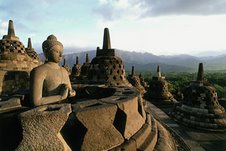Indonesia is a vast equatorial archipelago of 17,000 islands extending 5,150 kilometers (3,200 miles) east to west, between the Indian and Pacific Oceans in Southeast Asia. The largest islands are Sumatra, Java, Kalimantan (Indonesian Borneo), Sulawesi, and the Indonesian part of New Guinea (known as Papua or Irian Jaya). Islands are mountainous with dense rain forests, and some have active volcanoes. Most of the smaller islands belong to larger groups, like the Moluccas (Spice Islands).
Indonesia, the world's fourth most populous nation, is 87 percent Muslim—and the largest Islamic country, though it is a secular state. Indonesians are separated by seas and clustered on islands. The largest cluster is on Java, with some 130 million inhabitants on an island the size of New York State (60 percent of the country's population). Sumatra, much larger than Java, has only about a third of its people. Ethnically the country is highly diverse, with over 580 languages and dialects—but only 13 have more than one million speakers.
After independence from the Netherlands in 1949, the new republic confronted a high birthrate, low productivity, and illiteracy—areas in which progress has since been made. The government used a "transmigration" policy to address uneven population distribution by relocating millions of people from Java to other islands. Unity and stability are improving, although outer areas of the archipelago resent domination by Java. The Asian financial crisis hit Indonesia extremely hard. Public unrest, including violent rioting, forced President Suharto—in office since 1967—to resign in May 1998. One year later Indonesia conducted its first democratic elections since 1955.
The democratic government faces many problems after years of military dictatorship. Secessionists in the regions of Papua and Aceh (northwest tip of Sumatra) have been encouraged by East Timor's (now Timor-Leste) 1999 success in breaking away after 25 years of Indonesian military occupation. Militant Islamic groups have become active in recent years, and religious conflict between Muslims and Christians recently flared in Sulawesi and the Moluccas. The island of Bali, a center of Hindu culture, suffered a terrorist bomb blast in 2002 that killed over 200 people—mostly tourists.
Export earnings from oil and natural gas help the economy, and Indonesia is a member of the Organization of Petroleum Exporting Countries (OPEC). Tourists come to see the rich diversity of plants and wildlife—some, like the giant Komodo dragon and the Javan rhinoceros, exist nowhere else.
ECONOMYIndustry: petroleum and natural gas; textiles, apparel, and footwear; mining, cement, chemical fertilizers.
Agriculture: rice, cassava (tapioca), peanuts, rubber; poultry.
Exports: oil and gas, electrical appliances, plywood, textiles, rubber.
Text source: National Geographic Atlas of the World, Eighth Edition, 2004










0 comments:
Post a Comment